
In the world of industrial finishes, achieving precision and efficiency in your powder coating booth is paramount. Overspray — the fine particles of paint that don’t adhere to the intended surface — can be a costly and disruptive challenge. Not only does it waste materials, but it can also lead to environmental concerns and additional cleanup costs. This comprehensive guide will explore practical tips for controlling overspray in powder coating booths, ranging from design improvements to procedural enhancements. Whether you operate in small-scale paint spray booths or large blast booths, these strategies will help enhance your operation’s productivity and sustainability.
Proper Booth Airflow Design
The design of your powder coating booth plays a crucial role in minimizing overspray. Effective airflow systems ensure that excess powder is quickly and efficiently removed from the work area, thereby reducing waste and improving coating quality. It’s important to install a ventilation system that matches the size and capacity of your booth, ensuring that air circulates evenly and contaminants are effectively extracted. By focusing on tailored airflow designs, your operations can achieve a significant reduction in overspray, leading to a cleaner work environment and better-quality finishes.
Optimized Spray Gun Settings
Adjusting your spray gun settings is an essential step towards controlling overspray. This involves calibrating the air pressure, powder flow, and fan width to suit the specific needs of each job. By optimizing these settings, you can significantly reduce the amount of powder that misses the target. Training your technicians to understand and manipulate these settings can lead to a more targeted application, reducing waste and ensuring that each part is coated with the right amount of material. Remember, a little adjustment can go a long way in enhancing the overall efficiency of paint spray booths.
Electrostatic Attraction Techniques
Electrostatic attraction is a key technique in minimizing overspray in powder coating booths. By electrically charging the powder particles, they are attracted to the grounded workpiece, improving adhesion and reducing waste. This method not only enhances the finish quality but also contributes to the sustainability of your operations by decreasing the amount of powder needed. Incorporating advanced electrostatic technologies can transform the efficiency of your coating process, turning every spray into a precise, controlled application.
Strategic Part Positioning
The way parts are positioned within the booth can have a significant impact on overspray levels. Strategic placement ensures that the spray reaches the parts more effectively, which enhances coverage and minimizes waste. It’s crucial to regularly assess and adjust the positioning of parts based on their size, shape, and the type of coating being applied. This proactive approach not only improves the quality of the coating but also enhances the operational efficiency of blast booths.
Dry Filter Bank Maintenance
Maintaining the dry filter bank is essential for controlling overspray in your powder coating booth. Filters that are clogged or improperly maintained can lead to a buildup of excess powder, which not only affects the quality of the finish but also poses a risk to your equipment and work environment. Regular checks and replacements ensure that the airflow remains optimal, which is crucial for efficient overspray management. A well-maintained filter system is key to achieving consistent, high-quality finishes in both powder coating and paint spray booths.
Powder Recovery System Integration
Integrating a powder recovery system is an effective way to control overspray while enhancing the sustainability of your operations. These systems capture excess powder that can then be reused, reducing waste and lowering material costs. Whether you’re working in small-scale setups or large industrial blast booths, a well-integrated recovery system ensures that your operations are not only more efficient but also more environmentally friendly. Embracing these systems demonstrates a commitment to sustainable practices, setting your business apart in the competitive industrial coating market.
Conclusion
Controlling overspray in your powder coating booth is essential for optimizing both the quality of your finishes and the efficiency of your operations. By implementing these strategies — from refining airflow design and spray gun settings to leveraging electrostatic attraction and strategic part positioning — you can significantly reduce waste, improve productivity, and enhance sustainability. Regular maintenance of dry filter banks and the integration of powder recovery systems further support these goals, ensuring that your booth operates at peak performance. Embrace these practices to transform your powder coating operations into a model of efficiency and quality.

